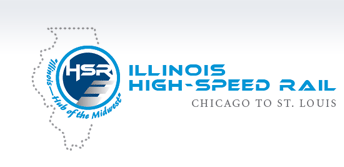![]()

Safety Program
Safety Goals
The Illinois Department of Transportation (IDOT) is dedicated to creating a safe and efficient transportation system. As such, a major portion of the investment in the Chicago to St. Louis corridor is to improve safety systems.
As part of the High-Speed Rail Program to accommodate trains operating at speeds up to 110 mph, several safety enhancements are underway. These improvements are described below:
Track Improvements
The track and infrastructure within the Chicago to St. Louis corridor has been upgraded with new premium rail, new stone ballast, and concrete ties.
Premium rail
The new premium rail is continuously welded. This allows for a strong track and provides for a smooth ride. The track allows for trains to travel at higher speeds and with less friction than jointed tracks. It also requires less maintenance.
Concrete Ties
The wooden ties have been replaced with concrete ties. The uniform quality and strength of concrete ties provides for an overall stronger track. This allows for a better alignment and rolling surface so that equipment lasts longer and requires fewer repairs. Concrete ties also are more resistant to weathering and erosion as compared to traditional wooden ties.
The Track Renewal Train was used on the Chicago to St. Louis Corridor to replace the rail, ties and ballast. A video of this can be seen in the Media Center.
Stone ballast
The new stone ballast is used to bear the load from the railroad ties and tracks. It consists of crushed stones and is, therefore, also used to facilitate drainage of water and to limit the growth of vegetation. In addition, the railroad ballast acts as a support base for the railroad track structure, not only giving it strength and rigidity, but also flexibility for when trains pass over it.
Grade Crossing Improvements
As part of IDOT's commitment to enhance safety along the Chicago to St. Louis Corridor, each grade crossing within the corridor was evaluated for potential improvements.
Four Quadrant Gates
The crossings have been equipped with four quadrant gates to better restrict vehicles from entering the path of a train. The use of four gates instead of two provides a "closed" system, which reduces the opportunity for motorists to enter the crossing zone improperly by weaving around the gates.
If a vehicle happens to drive across the tracks as the arms are descending, the far gate (or "exist gate") will ascend and allow the vehicle to safely continue on its course. The vehicle is noted on a vehicle detection system installed as part of the crossing improvements.
The objective of these gates and detection system is to ensure that all vehicles that clear the near gate (or "entrance gate") should also clear the far gate. Before the implementation of high-speed rail in the Chicago to St. Louis corridor, the crossing gates would have descended at least 20 seconds prior to the train's arrival at the crossing. This time will be extended to approximately 80 seconds before the arrival of a train at a crossing.
A video of the four quadrant gate operation can be seen on the Operation Lifesaver website.
Pedestrian Gates and Fencing
Railroad crossings not only can present safety issues for motorists, but also pedestrians, particularly those using wheeled devices, such as wheelchairs and scooters.
All pedestrian railroad crossings were evaluated to determine appropriate measures. The intent was to provide designs to minimize the time required for pedestrians to cross, while at the same time placing an emphasis on avoiding entrapment of the pedestrians on or between the railroad tracks.
In locations designated for pedestrian crossings, gates and fencing were installed. These enhancements were accompanied with a sidewalk, raised pavement markings, and signage.
Right-of-Way Fencing
Right-of-way fencing has been installed within urban areas and select rural areas. The fencing was installed within Union Pacific Railroad's right-of-way and will be maintained by Union Pacific.
Fencing locations were determined during field reviews conducted by the Illinois Commerce Commission, Union Pacific Railroad, and the Illinois Department of Transportation. Reviewers looked for pedestrian traffic generators, such as nearby schools and parks, as well as signs of current pedestrian trespass across the railroad tracks.
Ornamental fencing was installed within urban areas and chain-link fence was installed in locations outside of urban areas. Photographs of the typical urban area fencing can be seen in the Media Center.
Enhanced Signal Systems
Within the Chicago to St. Louis corridor, an enhanced railroad signal system is being implemented. All railroad warning devices at the rail-highway grade crossings have been upgraded.
The crossings also include Positive Train Control (PTC) and enhanced grade crossing warning system along the corridor that will allow trains on the line to properly communicate at crossings and along the corridor. The enhanced signal system allows trains to receive information about their locations and where safe travel is allowed. The system uses signals and sensors to communicate this information, along with speed restrictions and moving authority. It also makes use of radio communications to provide in-cab signals to the train engineer and gives the dispatcher the ability to stop a train in an emergency. In addition, this system will allow vehicles to be detected within the crossings, thus enabling actions, such as releasing the exit gates, to be taken to avoid a potential incident.
